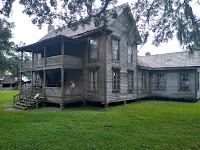My wife and I both love to cook (and eat), and we're often able to combine our passions for food and history. There are many ways to do this. You can seek out and sample various restaurants of various cultures. In many cities, there are annual cultural festivals, and food usually plays a big part of them. Bookstores have aisles of cookbooks focusing on particular places and times. And, like us, you may enjoy hands-on cooking classes.
Try Googling cooking classes and see what turns up. You may find local private chefs who come to your home and prepare a class/gathering for you and your friends, or you may find classes offered in stores. In Atlanta, there are several Cooks Warehouse stores where we have attended several classes and demonstrations. In Tampa, our new metro home, there is a store called Rolling Pin Emporium. Cooks Warehouse and Rolling Pin are higher end kitchen supply stores. If you have ever thought about needing a particular kitchen gadget, or even if you've never thought about it, they probably sell it. Besides selling kitchen gadgets and pots and pans, they have functioning kitchens to which they invite local and celebrity chefs to lead classes, usually after store hours. If you pick a hands-on class, you and your classmates (usually a small number like 10-16) prepare a menu created by the chef, under the supervision of the chef and the store's volunteer kitchen aides. You learn cooking styles, tricks, and menus, and you get to eat a meal which you helped prepare at the end of the night. If you choose a demonstration class, you will probably see a local or national celebrity chef and the kitchen volunteers prepare a dinner menu, usually from their just-published cookbook. Along the way, the chef tells stories and answers questions, and in the end, you have a delicious meal.
In Atlanta, we took several classes including Cajun, Persian, and Indian menus, and we also took several classes with Chef Christy Seelye-King. ( https://askchefchristy.com/ ) Chef Christy is a culinary historian who has studied various cultures and periods. She then creates menus based on her research and then leads classes, usually in costume. We did a Viking Mead Hall class with her, as well as classes on African and Irish cooking. We learned a lot, had great food, and had a great time in each class.
Stores like Cooks Warehouse and Rolling Pin also attract nationally know chefs and cookbook authors on book tours. They stop in and do demonstration classes. We've met two of the most respected southern chefs around in demonstrations. We met Nathalie Dupree last fall at Cooks Warehouse and Virginia Willis last week at Rolling Pin. Both women were incredibly gracious, funny, and friendly taking time to tell great stories, talk to everyone and sign books and take pictures. To top it off, attendees got to et great meals that they prepared. How many people can see that they got to eat the cooking of tv food personalities they've watched for years?
My wife and I are such foodies that we will also attend book talks by our favorites, even when they're not serving food. Whenever they have just-published cookbooks, chefs hit the book tour, just like other authors. At the Atlanta History Center, we attended talks by and met Sean Brock, another highly respected southern chef, and Carla Hall, Top Chef contestant, Chew co-host, Food Network personality, and southern chef (notice a theme?). We got signed books, heard great stories, and got to meet them. (If you ever get the chance to meet Carla Hall, do it. She is incredibly sweet, funny, and personable, just like she appears on tv.
Book festivals usually have chefs appearing as well. At the Savannah Book Festival a couple of years ago, we met another Top Chef contestant Ed Lee, when he was talking about his excellent book, Buttermilk Graffiti.
Get out there and eat your history! Search for opportunities in your area to explore, learn, and enjoy.


















































